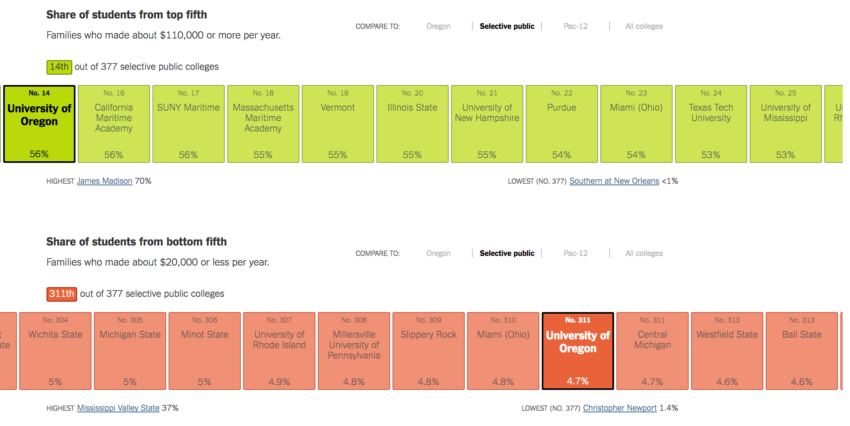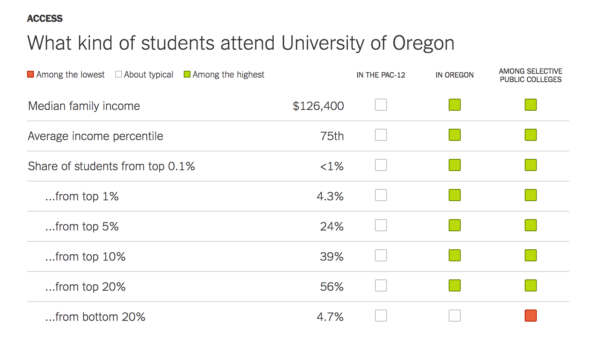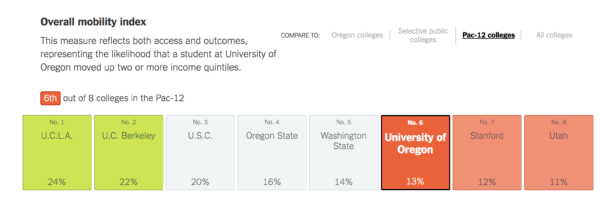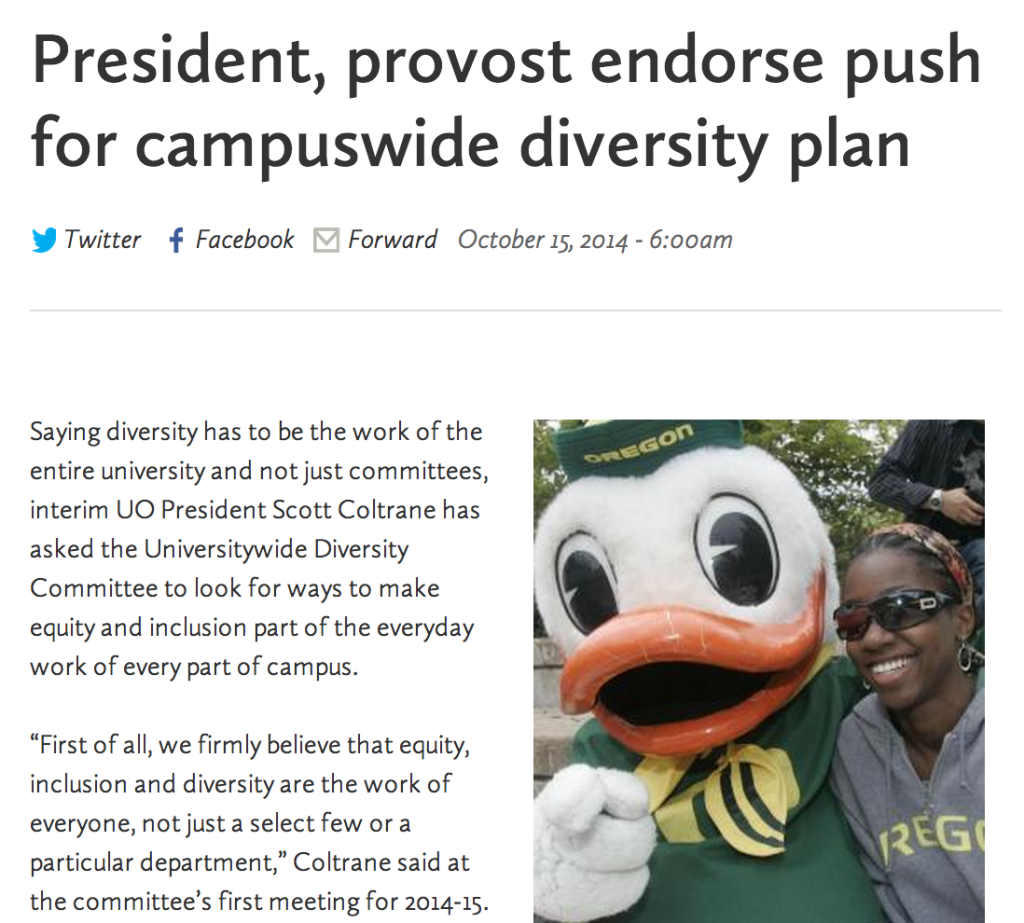From InsideHigherEd, here: December’s Notices of the American Mathematical Society contains a surprising column on Page 4, given that mathematicians have not been on the front lines of debates about diversity and campus speech. The column, by Abigail Thompson, chair of math at the University of California, Davis, and one of the society’s vice presidents, says…
Posts tagged as “Diversity”
That would be UO student diversity of thought. Emerald reporter Mateo Sundberg has the report on yesterday’s debate in a packed PLC 180 classroom between the student Republicans and Democrats. Before clicking on the link for the story here, please humor me and enter your guess in the comments as…
10/17/2017: I’m not going to live blog this – Bruce Blonigen will post the notes on the CAS diversity web page. There are a few undergrads, about 15 grad students (particularly women from the sciences) and about 5 people from the dean’s office. Andrew Marcus does a good job inviting…
The UO administration is now requiring all search committee members to take a two-hour training on implicit bias. I did an abbreviated version at a BOT meeting last year, and I’m at one of the three long versions right now, with about 60 other faculty and administrators. The presenter, Erik…
8/7/2017: UO is failing on economic diversity. Where’s the “Economic Diversity Action Plan”?
UO is ranked #328 out of 377 selective public colleges for promoting income mobility. 56% of our students come from families in the top 20% of the income distribution (4.3% from the top 1%) and only 4.7% come from the bottom 20%:

Our economic diversity has been getting worse over time (except perhaps for a small recent blip):

Despite this poor performance and the bad trends, UO’s long debates about diversity have generally ignored economic diversity. UO’s Institutional Research website has pages and pages of tables slicing and dicing UO’s students and faculty by every imaginable diversity metric – so long as those metrics are race and ethnicity or gender. The good news is that UO has improved markedly by all those measures over the past 10-15 years.
However, if you believe economic opportunity and diversity are important, you will have no luck finding that information on the IR website. If you go to UO’s Office of Equity and Inclusion’s “IDEAL Plan” you’ll find that the latest version now pays lip service to economic diversity, but you will not find a word about how UO compares on the relevant measures, or on the time trends. Similarly, the “Diversity Action Plans” that are now under preparation by every academic and administrative unit under the supervision of Equity and Inclusion have little if anything to say about economic diversity – it’s all race with a bit of gender.
Fortunately there is a new paper out with the data for UO and other colleges:
Mobility Report Cards: The Role of Colleges in Intergenerational Mobility
Raj Chetty, John Friedman, Emmanuel Saez, Nicholas Turner, and Danny Yagan
National Bureau of Economic Research Working Paper No. 23618, Revised Version, July 2017
Fact sheet: PDF
Non-technical summary: PDF
Paper: PDF
Slides: PDF | PPT
Data: Stata / Excel
NYT Interactive Tool to Explore Data: Web
Unfortunately that paper makes it very clear UO is failing when it comes to promoting economic diversity. The figures at the top of this post come from the NYT summary for UO:
A new study, based on millions of anonymous tax records, shows that some colleges are even more economically segregated than previously understood, while others are associated with income mobility.
Below, estimates of how University of Oregon compares with its peer schools in economic diversity and student outcomes.
The median family income of a student from University of Oregon is $126,400, and 56% come from the top 20 percent. About 1.4% of students at University of Oregon came from a poor family but became a rich adult.


When it comes to economic diversity UO is near the bottom whether you look at selective publics, the PAC-12, or other Oregon universities:



It would be nice to believe that these sad results will help drive UO’s diversity debate and spending priorities for promoting diversity.
This does not seem to include spending on the UMRP, probably about $1M a year, or spending by the colleges: Here’s a snippet of the 2015-16 Equity and Inclusion’s operations spending. From what I can tell none of it went to help students pay tuition. Outside consultants got $360K for “services and supplies” –…
Mateo Sundberg’s Op-Ed is on the Daily Emerald website here: Over one year ago, the Black Student Task Force released a list of twelve demands for the University of Oregon administration to address campus issues surrounding diversity and tolerance. One of the demands, demand number six, was a request for the…
Nicholas Kristof is the son of two PSU professors and grew up on a farm in Oregon. A few years ago we got him to come to campus and talk to our SAIL students. He is arguably the most liberal of the NY Times’s columnists, although it’s tough to top Krugman. Here’s his…
Longtime readers may remember that my public records obsession started back in 2006, after former UO General Counsel Melinda Grier and AAEO Penny Daugherty (still) tried to hide UO’s affirmative action plans, and the fact that Daugherty had failed to do them for several years. Grier stonewalled my PR requests for months, and then…
Wednesday, April 13, 2016 at 2:30 pm HEDCO Education Building, Room 240. It’s a telephonic meeting, but apparently there will be a phone there to listen in. The full draft of the proposal is here. From what I can tell this is the first specific reference to the administration’s use of the confidential Academic…
UO Professor Naomi Zack (Philosophy) is talking today at 12:00 at the ceremony in the Ford Alumni Center. She asked me to post this Eric Kelderman report on her thoughts about the award, in the Chronicle here: … Ms. Zack said she was skeptical of some of the measures underway at…
Today at 11:30 AM, Global Scholars Hall.
Dear Campus Community,
11/4/2014 update: UO Auditor to investigate Affirmative Action waiver for Triplett hire
The UO administration spends millions on promoting student and faculty diversity. But will it follow the law when it comes to hiring Johnson Hall administrators? UO’s new Auditor is going to look into it:
From: Brenda Muirhead <brendam@uoregon.edu>
To: William Harbaugh <harbaugh@uoregon.edu>
Subject: RE: PR request, AAEO documents
Date: November 4, 2014 at 3:47:51 PM PST
Bill,
Thank you for the email yesterday. I will review this case and determine if a request to waive a search was appropriately approved for this position. If you have any questions about the fraud and ethics reporting process, please don’t hesitate to contact my office at 541-346-6541.
Brenda Muirhead
UO Office of Internal Audit
11/3/2014: UO violated Title VII in Asst VP of Collaboration hire, according to Public Records Office:
Title VII is the section of the 1964 Civil Rights Act involving hiring, generally known as “affirmative action”. UO’s affirmative action policies require basic good hiring practices such as an open search and public job announcement, or an explanation for the exception. I’m no detective, but I think this evidence that UO violated its policies in hiring its new Assistant VP for University Initiatives and Collaboration is called “the dog that didn’t bark”:
From: “Thornton, Lisa” <pubrec@uoregon.edu>
Date: October 16, 2014 at 12:14:09 PM PDT
Subject: Public Records Request 2015-PRR-076
10/16/2014
Dear Mr. Harbaugh-
The University does not possess records responsive to your request made 10/06/2014 for “documents related to the job search for the new UO Assistant VP for University Initiatives and Collaborations… [s]pecifically I am requesting any documents showing exemptions or exceptions to the UO job search procedures”. [The full request is below].
The office considers this to be fully responsive to your request, and will now close your matter. Thank you for contacting the office with your request.
Sincerely,
Lisa Thornton
Office of Public Records
University of Oregon
Office of the President
Presumably Ms Thornton and Dave Hubin have already brought this potential non-compliance with state and federal affirmative action law to the attention of Interim General Counsel Doug Park, for swift investigation and appropriate remedial efforts. But just in case, I have cced Park on the notification – at the risk of another set of retaliatory emails from him, accusing me of harassment.
10/16/2014: Administration kicks off diversity plan by hiring new AVP without an affirmative action search
“Around the 0” has the latest window dressing, here:
Sounds great. So, did they do an affirmative action compliant search for their latest Assistant VP hire? Doesn’t seem likely:
Subject: Re: PR request, AAEO documents
Date: October 15, 2014 at 11:04:18 AM PDT
To: Lisa Thornton <pubrec@uoregon.edu> Cc: doug park <dougpark@uoregon.edu>
Dear Ms Thornton
It’s been more than a week since I made this PR request. I would appreciate it if you could let me know when you expect to be able to provide the documents.
On MondayOct 6, 2014, at 3:19 PM:
Dear Ms Thornton –
This is a public records request for documents related to the job search for the new UO Assistant VP for University Initiatives and Collaborations, announced here: http://around.uoregon.edu/content/uo-gains-statewide-education-system-expertise-latest-hire
Specifically I am requesting any documents showing exemptions or exceptions to the UO job search procedures explained at http://ups.uoregon.edu/content/new-appointments and http://ups.uoregon.edu/content/interim-recruitment-guidelines-unclassified-personnel
I believe that this search and hire may have violated UO policies and procedures, and Oregon and Federal affirmative action hiring laws, and therefore I ask for a fee waiver on the basis of public interest.
10/1/2014: Chuck Triplett, who helped Pernsteiner fire Lariviere, now works in JH
Excellent reporting. Read it all, here: … Targeting low-income students helps diversity because minority students are statistically more likely to fall into the low-income bracket, according to Grant Schoonover, an adviser for Pathway Oregon. “There’s a greater number of first generation and historically underrepresented students in that cross-section,” Schoonover said.…
Update: With the faculty hiring season well under way, I thought I’d repost this classic.
7/4/2013 AA Plan update: For the first time in living memory, Penny Daugherty’s Affirmative Action Office has managed to complete the federally required annual update to UO’s AA Plan on schedule. Last time she and Randy Geller got President Gottfredson to backdate it just as Frohnmayer regularly did, making it look like UO was in compliance when it wasn’t. The updates are here, the “Executive Order” report deals with race and gender.
Take a look at Table 3 on page 41. Using the federally specified methodology and the latest NCES data, UO’s tenure track faculty is representative of the available pool of Phd’s with respect to race/ethnicity in every single job group. For women, there is under-representation in Music, Education, CAS Humanities, and CAS Sciences:
How can this be, when a quick glance around UO reveals so few minorities? It’s because the available pool of minority PhD’s is very small. Logically, you’d think we should focus our efforts on increasing the number of minorities who get PhD’s. (Which the recent SCOTUS decision leaves some scope for.)
Nope. Instead we’ve developed a “beggar thy other universities” Under-represented Minority Recruitment Plan, paying departments $90K for every existing racial or ethnic minority TTF PhD we are able to keep another university from hiring. UO spends about $1M a year on this. And to add to the absurdity, there’s nothing in the UMRP for hiring women, and it doesn’t apply to NTTFs. And don’t get me started on SES, political, or religious diversity. UO wants faculty who look different, not faculty who think different.
When it comes to UO’s central administration , they mostly care about hiring their cronies for “special assistant” jobs without open affirmative-action compliant searches. Former Journalism Dean Tim Gleason is the latest case.
Back in 2006 I filed a complaint with the DOE’s Office of Civil Rights about the UMRP, which at the time was giving the money directly to the minority faculty, who often took it as summer salary. Unequal pay for equal work. It took a lot of public records requests, a bar ethics complaint against Melinda Grier, and a long talk with Associate AG David Leith at the Oregon DOJ, but eventually UO changed the plan to give the money to departments, and require them to ensure the funding was not distributed solely on the basis of race.
So while the UMRP may now be mostly legal (though see below for some of the stunts Russ Tomlin pulled) it’s still stupid, and there’s no sign that new VPAA Doug Blandy is going to try and fix it.

